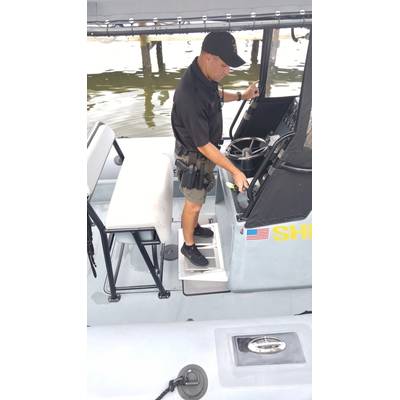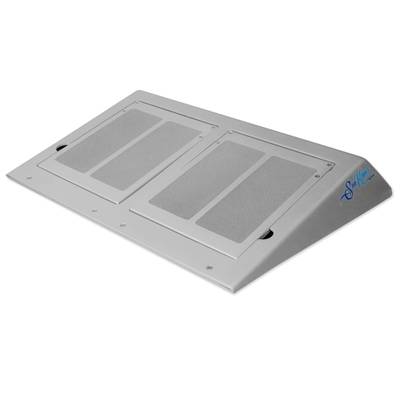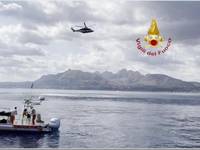Sea Knees Helps Boat Operators Stand Pain-free
Shock mitigation device absorbs impact brought about by rough seas
John Haas spent most weekends for the past two decades living on the open water. Eventually, the continual pounding took a toll on his health, and he developed a herniated disk that required him to temporarily discontinue his favorite pastime. He even needed surgery and extensive rehabilitation to get back to normal health.
“When the disk was coming out, it felt like a tongue sticking into my spinal cord,’’ said Haas, a resident of Stuart, Fla. “I didn’t have any feeling in my right leg. First it was pain, and then went numb. It got to the point that I hated going out on the boat on Saturday and Sunday, and then feeling like dog meat for days afterwards.”
After nine months away from the water, Haas became aware of a recently-developed product, Sea Knees, that claimed to mitigate the shock on boat operators. Haas said he’d try the device “to be nice” to Paul Nowack, the designer and also a resident of Stuart. He remained skeptical. “In any investment, I do a long process of due diligence and research,’’ Haas said. “And since I had the back surgery, I was afraid of how I’d feel.”
Almost instantly, Haas felt the difference. Sea Knees, a platform upon which the boat operators stand while operating the boat, dramatically reduced the impact throughout his body. Sea Knees’ performance was borne out in test data that measured G-force impact across three axes -- left to right, vertical, and front to back. In every measurement, G-force impact was reduced substantially with Sea Knees.
“I could feel it almost instantly,’’ said Pete Peterson, who operates a boat for nearly seven hours daily. “You can feel the difference. Your knees and back are not as sore. You’re not as beat up at the end of the day. I had tried some other products and could feel a tiny bit of difference. With Sea Knees, I noticed a huge difference, especially running off-shore.”
Nowack, a lifelong boat operator and tool tinkerer, set out to develop a device to reduce the impact on boat operators. The more difficult challenge, however, was devising a solution. “The biggest thing was trying to make this simple,’’ Nowack said. “It had to be small and compact so that it could fit in most boats. I also had to steer away from pneumatics and hydraulics. A boat is not a friendly environment in salt water. Anything with small motors, cables and retrofitting them would have been a challenge and maintenance nightmare.”
Sea Knees include a platform upon which boat operators stand while driving their boat. Under the skid-proof panels are compressive devices that hinge and swivel to reduce the impact on the legs. The compressive units hinge on plastic bearings. “The bearings are taking the brunt of the impact,’’ Nowack said.
The bearings in Sea Knees are manufactured by igus, inc., a motion plastics manufacturer based in Germany that runs its North American operations out of Providence, R.I. Each Sea Knees unit includes eight igus bushings, to help mitigate the shock from the ocean surf.
Nowack designed Sea Knees with a different bearing before switching to igus’ igus iglide R bushings. The bushings are maintenance free, stand up to the harsh ocean elements and are nearly 80 percent less costly than the components he had been using.
“I had used a similar bearing but it was a different material,’’ Nowack said. “What I liked about the bearings were that they were maintenance free and I knew they would work well in salt water. You can get a lot of nasty stuff in the ocean. We needed a bushing that had a long life, didn’t require maintenance and could stand up to salt water.”
To test Sea Knees, Nowack had boat operators and a mate travel for five minutes in 3-5 foot seas with winds around 13 mph. The boats traveled at about 30 knots – about 34 miles per hour – and both people were fitted with G-force measuring devices. In one particularly harrowing moment, the G-force without Sea Knees surpassed 8 – which is more than Apollo 16 astronauts absorbed on re-entry into the atmosphere in 1972 – and fighter pilots often have to endure G-forces of 8-9. Throughout the test sessions, Sea Knees reduced G-force impact by 50 percent or more.
“I was pleasantly surprised when we reviewed the data,’’ Nowack said. “I knew it was making my knees and joints feel better. Having the data to confirm it was a huge part of the project.”
Boat operators might be unaware of Nowack’s testing data, but they notice the results almost immediately when they’re on the water. “When you’re the captain on a boat, you’re constantly correcting for the elements,’’ said Steve Powers, who owns a Sea Tow franchise in Key Largo, Fla. “It really works your core. On a boat, you’re constantly holding on, shifting your weight, or making some sort of compensation for waves and elements. When you’re in choppy water, you don’t realize the vibration effect is compressing your spine and the damage it’s doing to your body. Having Sea Knees absorbs a lot of that impact.”
Sea Knees offers permanent and portable models and can be made in single and double units. With the fast-growing center console boating industry – they now comprise more than 50 percent of all saltwater fishing boats, according to the National Marine Manufacturers Association – Sea Knees can help boat operators enjoy a far longer and injury-free ride.
“With this product still on my mind and the center console business booming, where the majority of boat operators stand, I decided to give it a try,’’ Nowack said. “I knew that this product would work. This is an economical and effective way to reduce shock.”
The Author
Thomas Renner writes frequently on manufacturing, building and construction for United States trade publications.








